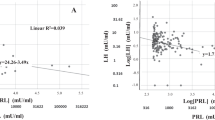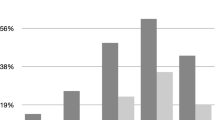Abstract
Erectile dysfunction (ED), generally associated with reduced sexual desire and sometimes with orgasmic or ejaculatory dysfunction, is the major revealing symptom of hyperprolactinemia (HPRL) in men, a condition that should not be neglected since many cases result from pituitary tumors, likely to result in serious complications. It is generally believed that the mechanism of the prolactin (PRL)-induced sexual dysfunctions is a decrease in testosterone secretion. In fact, serum testosterone is normal in many hyperprolactinemic males and there are also testosterone-independent mechanisms, probably mainly set at the level of the brain's neurotransmittor systems. Systematic determinations of serum PRL found very low prevalences of marked HPRL (>35 ng/ml) in ED patients (0.76% in a compilation of over 3200 patients) as well as of pituitary adenomas (0.4%). In addition, the association of HPRL with ED may have been coincidental in some of these cases, since 10% of the HPRLs diagnosed by the usual immunological assays are composed of macroprolactins, which are biologically inactive or little active variants of PRL. Their identification requires a PRL chromatography that is restricted to some specialized laboratories. There is presently no consensus with regards to the screening for HPRL in ED: systematic determination of serum PRL may be justified since HPRL is a serious but reversible disease, while there is presently no reliable clinical, psychometric or hormonal criteria (including serum testosterone level) allowing to restrict its determination to certain categories of the ED patients without risk of neglecting some HPRLs. In case of consistent HPRL, searching for a hypothalamic or pituitary tumor is mandatory. Dopamine-agonist therapy is the first choice treatment for the PRL-induced sexual dysfunctions. Additional sexual counselling may be necessary for certain patients.
This is a preview of subscription content, access via your institution
Access options
Subscribe to this journal
Receive 8 print issues and online access
$259.00 per year
only $32.38 per issue
Buy this article
- Purchase on Springer Link
- Instant access to full article PDF
Prices may be subject to local taxes which are calculated during checkout
Similar content being viewed by others
References
Haake P et al. Absence of orgasm-induced prolactin secretion in a healthy multi-orgasmic male subject. Int J Impot Res 2002; 14: 133–135.
Buvat J et al. Hyperprolactinemia and sexual function in men. Hormone Res 1985; 22: 196–203.
Carani C et al. Testosterone and prolactin: behavioural and psychophysiological approaches in men. In: Bancroft J (ed). The Pharmacology of Sexual Function and Dysfunction. Esteve Foundation Symposia, Vol. 6, Excerpta Medica. Elsevier Science: Amsterdam, 1995; pp 145–150.
Vermeulen A, Ando S, Verdonck L . Prolactinomas. Testosterone-binding globulin and androgen metabolism. J Clin Endocr Metab 1982; 54: 409–413.
Bancroft J, O'Caroll R, Neilly A, Shaw R W . The effects of bromocriptine on the sexual behavior of hyperprolactinemic man: a controlled case-study. Clin Endocrinol 1984; 21: 131–137.
Lobo RA, Kletzky OA . Normalization of androgen and sex-hormone-binding globulin levels after treatment of hyperprolactinemia. J Clin Endocr Metab 1982; 56: 562–566.
Drago F, Pellegrini-Quarantotti B, Scapagnini U, Gessa G L . Short-term endogenous hyperprolactinemia and sexual behavior of male rats. Physiol Behav 1981; 26: 277–279.
Selmanoff M . Tyrosine hydroxylase and POMC mRNA in the arcuate region are increased by castration and hyperprolactinemia. Mol Brain Res 1991; 10: 277–281.
Buvat J . Hormones et comportement sexuel de l'homme: données physiologiques et physiopathologiques. Contr Fertil Sex 1996; 24: 767–778.
Rehman J et al. Experimental hyperprolactinemia in a rat-model: alteration in centrally mediated neuroerectile mechanisms. Int J Imp of Res 2000; 12: 23–32.
Johnson AR, Jarow JP . Is routine endocrine testing of impotent men necessary? J Urol 1992; 147: 1542–1543.
Kropman RF et al. Routine endocrine screening in impotence: significance and cost-effectiveness. Int J Impot Res 1991; 3: 87–94.
Maatman TJ, Montague DK . Routine endocrine screening in impotence. Urology 1986; 27: 499–502.
Leonard MP, Nickel CJ, Morales A . Hyperprolactinemia and impotence: why, when, and how to investigate? J Urol 1989; 142: 992–995.
Akpunonu BE et al. Routine prolactin measurement is not necessary in the initial evaluation of male impotence. J Gen Intern Med 1994; 9: 336–341.
Buvat J, Lemaire A . Endocrine screening in 1022 men with erectile dysfunction: clinical significance and cost-effective strategy. J Urol 1997; 158: 1764–1767.
Johri AM, Heaton JPW, Morales A . Severe erectile dysfunction is a marker for hyperprolactinemia. Int J Impot Res 2001; 13: 176–182.
Buvat J, Lemaire A, Buvat-Herbaut M, Marcolin G . Dosage de la prolactine chez les impuissants. Presse Med 1989; 18: 1167.
Ambrosi B et al. Studies of the effects of bromocriptine on sexual impotence. Clin Endocrinol (Oxf.) 1987; 7: 417–420.
Schwartz MF, Bauman JE, Masters WH . Hyperprolactinemia and sexual disorders in men. Biol Psychiat 1982; 17: 861–876.
Sinha YN . Structural variants of prolactin: occurrence and physiological significance. Endocr Rev 1995; 16: 354–369.
Vallette-Kasic S et al. Macroprolactinemia revisited: a study on 106 patients. J Clin Endocrinol Metab 2002; 87: 581–588.
Lemaire C et al. Hyperprolactinemia with an excess of high molecular weight prolactin in men. Int J Impot Res 1994; 6 (Suppl 1): P79.
Guay AT, Sabharwal P, Varma S, Malarkey W B . Delayed diagnosis of psychological erectile dysfunction because of the presence of macroprolactinemia. J Clin Endocr Metab 1996; 81: 2512–2514.
Carani C, Granata AR, Fustini MF, Marrama P . Prolactin and testosterone: their role in male sexual function. Int J Androl 1996; 19: 48–54.
Garg RK, Khaishgi A, Dandona P . Is management with Sildenafil changing clinical practice? Lancet 1999; 353: 375–376.
Author information
Authors and Affiliations
Corresponding author
Rights and permissions
About this article
Cite this article
Buvat, J. Hyperprolactinemia and sexual function in men: a short review. Int J Impot Res 15, 373–377 (2003). https://doi.org/10.1038/sj.ijir.3901043
Received:
Revised:
Accepted:
Published:
Issue Date:
DOI: https://doi.org/10.1038/sj.ijir.3901043
Keywords
This article is cited by
-
Effects of cabergoline and dimethylcabergoline on the sexual behavior of male rats
Psychopharmacology (2024)
-
Omega 3 fatty acid improves sexual and erectile function in BPF-treated rats by upregulating NO/cGMP signaling and steroidogenic enzymes activities
Scientific Reports (2023)
-
Comparison of American Urological Association and Endocrine Society guidelines on testosterone replacement
International Journal of Impotence Research (2022)
-
No evidence for prolactin’s involvement in the post-ejaculatory refractory period
Communications Biology (2021)
-
Evaluation of sex hormone profile and semen parameters in acromegalic male patients
Journal of Endocrinological Investigation (2021)



